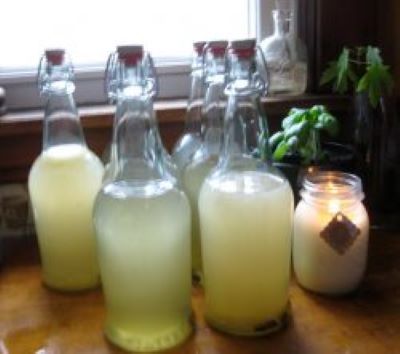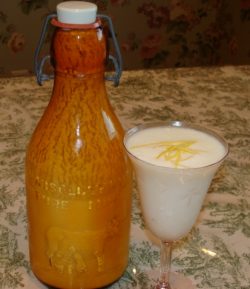
This is the follow up to Top 5 Femented Foods

Sima looks a bit like lemonade.
Fermented beverages have been a staple of the human diet since practically the dawn of (recorded) time (or at least 9000 years ago). Without modern refrigeration techniques, people sought other methods to preserve food and mitigate spoilage. Fermentation is one of the ubiquitous methods of preservation utilized by all cultures.
Using naturally occurring bacteria and yeast to ferment native foodstuffs didn’t only protect them from spoilage, it also added pro-biotic food to their diet and boosted their nutritional intake. Not only that, many fermented foods contain enzymes humans need to more effectively derive nutrition from their food. Whether they knew it or not, ancient peoples benefited in many ways from fermented foods.
Most people today are pretty disconnected from the natural world, especially the natural bacteria that are disinfected out of our lives. In some cases, that is good. Certainly nobody wants to catch the plague! However, I believe that our “war on bacteria” is at the root of a whole host of heretofore never before heard of “modern illnesses,” both mental and physical. As a society, we are severely out of (bacteria) balance. Correcting that balance is what fermented drinks are all about!
So, to that end, let’s take a look at a few interesting drinks from around the world. Many of these are ancient beverages and their popularity throughout the ages demonstrates the power of fermentation. It’s hot baby!
5. Sima
Sima is a traditional beverage of the Finnish people. It is made and served during Vappu, the Finnish May Day celebration. While normally a stoic people, Vappu is considered the one time of year that they really let their hair down. Like most May Day celebrations, its roots are from the Pagan tradition. Sima is a quick and easy ferment (warning: pdf!) with lemons (AMZ), sugar and yeast. The short fermentation cycle (of which the conclusion is indicated by raisins added to the bottling stage that float to the top) reduces the amount of alcohol present. While drunk by adults, it is also popularly served to kids, as many other cultures have more accepting attitudes towards low doses of alcohol for children.4. Boza or Bouza
Boza is a traditional fermented drink whose roots have been traced all the way back to Mesopotamia, 8000-9000 years ago. It is mainly made from hulled millet, which is boiled in water and then poured into broad shallow pans. When cool, the mixture is strained through a sieve (AMZ), and water and sugar are added. Boza is produced in most Turkish regions and in Bulgaria, Albania and Romania. Bouza is produced in Egypt and is most likely the forerunner of beer in Ancient Egypt. Different cereals (wheat, millet and rye) can be used for Boza production, and natural mixtures of yeasts and lactic acid bacteria cause fermentation. Starter from a previous batch is used and both lactic-acid bacteria and Saccaromyces (same yeast as in Komb…hold on. I don’t want to ruin the surprise of #1) are involved in the fermentation process.3. Milk Kefir/Water Kefir (tie)
Those were interesting to read about – now let’s get to some more familiar fermented friends! I LOVE Milk Kefir. Its smooth and creamy and filling – a perfect snack. Though often referred to as drinkable yogurt, kefir is so much more.CLICK HERE for a Milk Kefir Recipe, Tips, and Info

Second Ferment Kefir
CLICK HERE for a Coconut Water Kefir Recipe
2. Ginger Beer
This one is on my to-do list for sure. I confess to totally digging on the Reed’s Ginger Brew, but just like the booch, that stuff gets expensive. Reading about how to make this version myself had my mouth watering, I was so excited. I’ve got to carve out time to make this recipe (and visit this cool site again). It says: “The British Excise Regulations of 1855 required that the drink contained no more than 2% alcohol, and usually it was far less potent: hence ginger beer became popular with children.” That’s exactly the kind of classification Kombucha (and other fermented drinks) needs: less than 2% allows for health benefits without buzz, IMHO. Oops, I let my #1 drink slip! You never would have guessed…1. Kombucha
Okay, so I am predictable, but what did you expect? You might look at others, even sample, but you always come back to the one you love. How about a special Kombucha fact, then? Something you’ve never heard before? Okay, I have heard from multiple people that Kombucha can be left bottled for nearly as long as you want! In fact, after a full year, Kombucha is reported to taste smooth and delicious, not tart or vinegary as one might expect. I’m not surprised, as I have found even 45 days or so produces somewhat the same effect, with a significant mellowing of the taste. But, is that drink Kombucha, or has it become something less alive or pro-biotic, lacking in the vital acids? Testing is the only way to find out. Another project.Check out these links for more on Fermented Drinks:
National Center for Biotenchnology Engineering
Science in School
DIan Stricker
June 27, 2017 at 9:34 pmI was interested in the ginger kombucha. I have a unopened bottle dated Jan 2017.
It’s now almost 7/17. I want to know if this is good to
consume. I donot care 4 the
flavor, what is best to delute? Was thinking of lemon
ade or mango juice.
Hannah Crum
May 17, 2018 at 9:57 amKombucha doesn’t ever “expire” though as you’ve observed, the flavor may not taste as good. We recommend diluting with water or juice but if the flavor just doesn’t do it for you, then send it down the drain as cleaner! More tips for what to do with Kombucha Vinegar are here –> https://www.kombuchakamp.com/top-5-uses-for-kombucha-vinegar
Sharon Bivens
April 27, 2013 at 2:45 amAre these fermented products acid or alkaline base?
Hannah Crum
April 28, 2013 at 10:44 pmMany of them will have an acid pH but create an alkalizing effect in the body when consumed similar to citrus & vinegar.
Marcus
October 10, 2012 at 4:37 amHi Hannah, I’m keen to try making some fermented drinks. Much of what I’ve read on your site sounds delicious. One question though, Im not interested in anything with alcohol in it, even a small amount. Are any of your drinks alcohol free? Are there ways to make the drinks so they are healthy but alcohol free? Maybe the dairy based ones are better? Any thoughts?
Hannah Crum
October 15, 2012 at 12:14 amAlcohol is a natural by-product of the fermentation process. In fact, your body also produces alcohol. Try experimenting with different ferments until you find the ones that support your organism. Nature loves bio-diversity so consuming a wide variety will yield the best results over time.